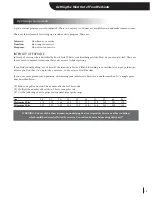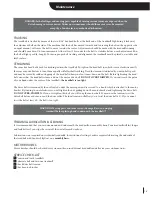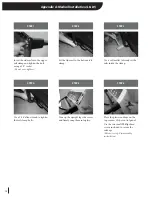
11
Getting the Most Out of Your Workouts
This depends on several things such as body weight, fitness goals, and what you like to do. Walking is the safest, most compati-
ble form of exercise for most people. If you’re just starting out, are new to exercise, or participate in aerobic activities less than
three times per week, we recommend that you walk. On the other hand, if you’re an experienced runner, stick with your pro-
gram – use your treadmill the way you want.
Here are some considerations to keep in mind:
[1]
If you’re interested in weight control, walking can burn as many calories as a moderate running pace. To get a very
small increase in caloric expenditure, you have to run fast and, for most people, the extra effort isn’t worth it.
[2]
Your chance of losing weight successfully is far greater with walking. Walking increases your daily caloric expenditure,
raises your metabolism, and is easier to stick with than running.
[3]
Heavy users should always walk until they’ve shed some extra pounds and are closer to their desired body weight. Extra
weight means extra stress on joints and muscles, which in turn means residual muscle soreness.
[4]
If you’re concerned about getting a “tough” workout and don’t think walking is adequate, try walking up a hill! You can
get just as much cardiovascular intensity (heart rate and breathing response) from walking as you can from running.
Don’t fool yourself with preconceived notions about walking – you can sweat just as much by walking as by running.
Take it easy! Walk. Lose weight in comfort. Avoid being sore and discouraged. After you’ve reached your target weight, reevalu-
ate. If you like walking and want to stick with it, terrific. On the other hand, if some running is appealing, try it out and see
what it’s like. Just remember that walking will get you fit and keep you fit.
This is very important to think about now. How much change in your fitness level and health do you expect to gain from
your walking/running program? How fast do you expect results?
Start by learning the fitness habit. Set reasonable, attainable goals for yourself. Set up a schedule and stick with it. Every time
you successfully complete a scheduled workout, give yourself a pat on the back. Practice your new “habit” faithfully and pretty
soon it will be built into your daily routine.
The point is this:
if you stick to your schedule the benefits will be yours. If you don’t, the benefits will escape you. Your
treadmill does nothing for you unless you’re on it walking or running. It’s just an inanimate object until you use it. Use it!
Get the benefits you deserve.
TIP:
If you’re the kind of person that sets up a schedule and can’t stick with it, then be very patient with yourself, because
fitness benefits are a function of how regularly you exercise.
Whatever your goals are, keep the end in mind. For example, if you want to lose weight, set up reasonable expectations with
your doctor. The key is “reasonable.” Regardless of the goal, be patient and persistent. It takes a while for your body to get the
message “we’re changing.”
TIP:
If weight loss/control is your personal objective, don’t forget the other half of the equation, diet. Get smart advice
from a professional.
Should you walk or run?
What are your expectations for success?
Содержание Pro Sports Trainer
Страница 23: ......






































